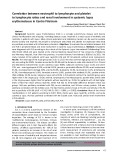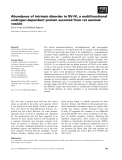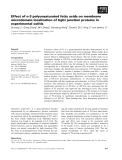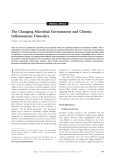
Inflammatory disorders
-
Hypertension is one of the major causes of cardiovascular diseases in the world. Periodontal disease is a chronic inflammatory disorder of the tissues surrounding the teeth. The objectives of this study were to determine the association between hypertension and periodontal parameters in periodontitis patients.
 6p
6p  vifaye
vifaye
 20-09-2024
20-09-2024
 1
1
 1
1
 Download
Download
-
Systemic Lupus Erythematosus (SLE) is a complex autoimmune disease with diverse clinical manifestations and relapsing - remitting disease course. To evaluate the correlation between NLR and PLR in peripheral blood and renal involvement in systemic lupus erythematosus.
 7p
7p  vifaye
vifaye
 20-09-2024
20-09-2024
 1
1
 1
1
 Download
Download
-
The potent immunomodulatory, anti-inflammatory and procoagulant properties of protein no. 4 secreted from the rat seminal vesicle epithelium (SV-IV) have previously been found to be modulated by a supramolecular monomer–trimer equilibrium.
 12p
12p  media19
media19
 05-03-2013
05-03-2013
 38
38
 3
3
 Download
Download
-
Ulcerative colitis (UC) is a gastrointestinal disorder characterized by an inflammatory process associated with mucosal damage. Many studies have shown that n-3 polyunsaturated fatty acids (PUFAs) possess anti-inflam-matory effects in inflammatory bowel disease.
 10p
10p  media19
media19
 05-03-2013
05-03-2013
 38
38
 5
5
 Download
Download
-
The S100 proteins are 10–12 kDa EF-hand proteins that act as central reg-ulators in a multitude of cellular processes including cell survival, prolifera-tion, differentiation and motility. Consequently, many S100 proteins are implicated and display marked changes in their expression levels in many types of cancer, neurodegenerative disorders, inflammatory and autoim-mune diseases.
 13p
13p  viettel02
viettel02
 19-02-2013
19-02-2013
 34
34
 1
1
 Download
Download
-
Abstract Intercellular signaling by cytokines is a vital feature of the innate immune system. In skin, an inflammatory response is mediated by cytokines and an entwined network of cellular communication between T-cells and epidermal keratinocytes. Dysregulated cytokine production, orchestrated by activated T-cells homing to the skin, is believed to be the main cause of psoriasis, a common inflammatory skin disorder.
 19p
19p  toshiba23
toshiba23
 18-11-2011
18-11-2011
 52
52
 2
2
 Download
Download
-
Tuyển tập các báo cáo nghiên cứu về y học được đăng trên tạp chí y học General Psychiatry cung cấp cho các bạn kiến thức về ngành y đề tài: The Changing Microbial Environment and Chronic Inflammatory Disorders...
 8p
8p  thulanh10
thulanh10
 09-10-2011
09-10-2011
 55
55
 2
2
 Download
Download
-
Metabolic and Inflammatory Disorders Acute febrile illnesses may result in vascular damage. This can result from immune complexes containing viral antigens or the viruses themselves. Certain pathogens, such as the rickettsiae causing Rocky Mountain spotted fever, replicate in endothelial cells and damage them. Vascular purpura may occur in patients with polyclonal gammopathies but more commonly in those with monoclonal gammopathies, including Waldenstrom's macroglobulinemia, multiple myeloma, and cryoglobulinemia.
 5p
5p  thanhongan
thanhongan
 07-12-2010
07-12-2010
 67
67
 3
3
 Download
Download
-
Harrison's Internal Medicine Chapter 109. Disorders of Platelets and Vessel Wall Disorders of Platelets and Vessel Wall: Introduction Hemostasis is a dynamic process in which the platelet and the blood vessel wall play key roles. Platelets become activated upon adhesion to von Willebrand factor (vWF) and collagen in the exposed subendothelium after injury. Platelet activation is also mediated through shear forces imposed by blood flow itself, particularly in areas where the vessel wall is diseased, and is also affected by the inflammatory state of the endothelium.
 5p
5p  thanhongan
thanhongan
 07-12-2010
07-12-2010
 93
93
 6
6
 Download
Download
-
Patients with leukopenias or leukocyte dysfunction often have delayed inflammatory responses. Therefore, clinical manifestations may be minimal despite overwhelming infection, and unusual infections must always be suspected. Early signs of infection demand prompt, aggressive culturing for microorganisms, use of antibiotics, and surgical drainage of abscesses. Prolonged courses of antibiotics are often required. In patients with CGD, prophylactic antibiotics (trimethoprim-sulfamethoxazole) and antifungals (itraconazole) markedly diminish the frequency of life-threatening infections.
 6p
6p  konheokonmummim
konheokonmummim
 03-12-2010
03-12-2010
 76
76
 5
5
 Download
Download
-
Harrison's Internal Medicine Chapter 61. Disorders of Granulocytes and Monocytes Disorders of Granulocytes and Monocytes: Introduction Leukocytes, the major cells comprising inflammatory and immune responses, include neutrophils, T and B lymphocytes, natural killer (NK) cells, monocytes, eosinophils, and basophils. These cells have specific functions, such as antibody production by B lymphocytes or destruction of bacteria by neutrophils, but in no single infectious disease is the exact role of the cell types completely established.
 5p
5p  konheokonmummim
konheokonmummim
 03-12-2010
03-12-2010
 96
96
 6
6
 Download
Download
-
Acne Rosacea Acne rosacea, commonly referred to as rosacea, is an inflammatory disorder predominantly affecting the central face. Those most often affected are Caucasians of northern European background, but it is seen in patients with dark skin also.
 5p
5p  konheokonmummim
konheokonmummim
 30-11-2010
30-11-2010
 95
95
 5
5
 Download
Download
-
Psoriasis (Table 53-2) Psoriasis is one of the most common dermatologic diseases, affecting up to 1% of the world's population. It is a chronic inflammatory skin disorder clinically characterized by erythematous, sharply demarcated papules and rounded plaques, covered by silvery micaceous scale. The skin lesions of psoriasis are variably pruritic. Traumatized areas often develop lesions of psoriasis (Koebner or isomorphic phenomenon). Additionally, other external factors may exacerbate psoriasis including infections, stress, and medications (lithium, beta blockers, and antimalarials).
 5p
5p  konheokonmummim
konheokonmummim
 30-11-2010
30-11-2010
 86
86
 6
6
 Download
Download
-
Posterior Ischemic Optic Neuropathy This is an infrequent cause of acute visual loss, induced by the combination of severe anemia and hypotension. Cases have been reported after major blood loss during surgery, exsanguinating trauma, gastrointestinal bleeding, and renal dialysis. The fundus usually appears normal, although optic disc swelling develops if the process extends far enough anteriorly. Vision can be salvaged in some patients by prompt blood transfusion and reversal of hypotension. Optic Neuritis This is a common inflammatory disease of the optic nerve.
 5p
5p  ongxaemnumber1
ongxaemnumber1
 29-11-2010
29-11-2010
 89
89
 5
5
 Download
Download
-
Episcleritis This is an inflammation of the episclera, a thin layer of connective tissue between the conjunctiva and sclera. Episcleritis resembles conjunctivitis but is a more localized process and discharge is absent. Most cases of episcleritis are idiopathic, but some occur in the setting of an autoimmune disease. Scleritis refers to a deeper, more severe inflammatory process, frequently associated with a connective tissue disease such as rheumatoid arthritis, lupus erythematosus, polyarteritis nodosa, Wegener's granulomatosis, or relapsing polychondritis.
 5p
5p  ongxaemnumber1
ongxaemnumber1
 29-11-2010
29-11-2010
 86
86
 6
6
 Download
Download
-
Differential Diagnosis Nausea and vomiting are caused by conditions within and outside the gut as well as by drugs and circulating toxins (Table 39-1).
 5p
5p  ongxaemnumber1
ongxaemnumber1
 29-11-2010
29-11-2010
 77
77
 4
4
 Download
Download
-
Table 38-2 Esophageal Dysphagia Esophageal Mechanical Dysphagia I. Wall defects A. Congenital B. Tracheoesophageal fistula II. Intrinsic narrowing A. Inflammatory esophagitis 1. Viral (herpes simplex, varicella-zoster, cytomegalovirus) 2. Bacterial 3. Fungal (Candida) 4. Mucocutaneous bullous diseases 5. Caustic, chemical, thermal injury 6. Eosinophilic esophagitis B. Webs and rings 1. Esophageal (congenital, inflammatory) 2. Lower esophageal mucosal ring (Schatzki's ring) 3. Eosinophilic esophagitis 4. Host-versus-graft disease, mucocutaneous disorders C.
 6p
6p  ongxaemnumber1
ongxaemnumber1
 29-11-2010
29-11-2010
 59
59
 3
3
 Download
Download
-
Infections of the Ear and Mastoid Infections of the ear and associated structures can involve both the middle and external ear, including the skin, cartilage, periosteum, ear canal, and tympanic and mastoid cavities. Both viruses and bacteria are known causes of these infections, some of which result in significant morbidity if not treated appropriately. Infections of the External Ear Structures Infections involving the structures of the external ear are often difficult to differentiate from noninfectious inflammatory conditions with similar clinical manifestations.
 5p
5p  ongxaemnumber1
ongxaemnumber1
 29-11-2010
29-11-2010
 66
66
 4
4
 Download
Download
-
Disorders of the Sense of Taste Disorders of the sense of taste are caused by conditions that interfere with the access of the tastant to the receptor cells in the taste bud (transport loss), injure receptor cells (sensory loss), or damage gustatory afferent nerves and central gustatory pathways (neural loss) (Table 30-2). Transport gustatory losses result from xerostomia due to many causes, including Sjögren's syndrome, radiation therapy, heavy-metal intoxication, and bacterial colonization of the taste pore.
 5p
5p  ongxaemnumber1
ongxaemnumber1
 29-11-2010
29-11-2010
 77
77
 7
7
 Download
Download
CHỦ ĐỀ BẠN MUỐN TÌM































